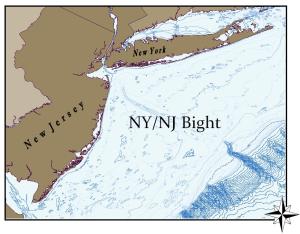The New York/New Jersey Bight is a little sea in the big ocean
Bight (bīt): n. – a curve or bend in a shoreline.
The coasts of New York and New Jersey and the continental shelf slope breakcreate a mini-sea “wedge” within the Atlantic Ocean, an area of water officially known as the “New York Bight.” The physical, biological, and hydrodynamic characteristics of this 19,000+ square-mile area are extraordinary.

New York Bight: alternatively defined as the waters from Montauk Point, NY to Cape May, NJ, and offshore to the outer edge of the Continental Shelf, or as also including the marine waters off of Rhode Island and Cape Cod.
History
The waters of the NY Bight have been used as a dumping ground since at least the 1800s. Until the early 1900s, disposal of raw sewage, garbage, refuse, and street sweepings occurred in the inner NY Harbor. As the local population soared, raw sewage and dead animals putrefied rivers, public health suffered, and odors and debris became gruesome and fearsome. As a solution, disposal activities were moved to the outer Harbor and then, eventually, to the ocean waters of theBight.
In 1984, with eight ocean dumpsites, the Bight was the “Ocean Dumping Capital of the World.” The eight dumpsites included those for contaminated dredged spoils, sewage sludge (two sites), acid waste, wood incineration, construction rubble, incinerated toxic wastes, and industrial wastes.
The Bight continues to show the consequences of this legacy of pollution – as well as contamination from non-point sources along the coastline: fish advisories from contaminated sediments, beach closures from runoff, storm drains, raw sewage discharge, and littered beaches.
Future
Though those “dump-and-dash” days may be behind us, there are still those who, looking to exploit the sea and threaten its ecosystem, view this living resource as a cheap disposal ground.
For the record, dilution is NOT the solution to pollution. Less pollution is the only solution to pollution.
The Bight is at the receiving end of the most densely populated urbanized area in the country, belching a steady toxic tide of poisons into the water. The fertile waters of the Bight are suffocating under a deluge of sediment, pesticides, petroleum products, and sewage. Regular fossil fuel energy application submissions are sent into the state and federal agencies in charge of managing the Bight and the resources therein – representing an ongoing threat to the ecosystem.
This unique and diverse special ocean area needs to be protected, promoted, celebrated, and secure – check out the Clean Ocean Zone initiative to find out how…
For more information on the Bight, contact us, and follow our blog for updates on pollution sources, advocacy, and industrialization – and to find out how to help!
